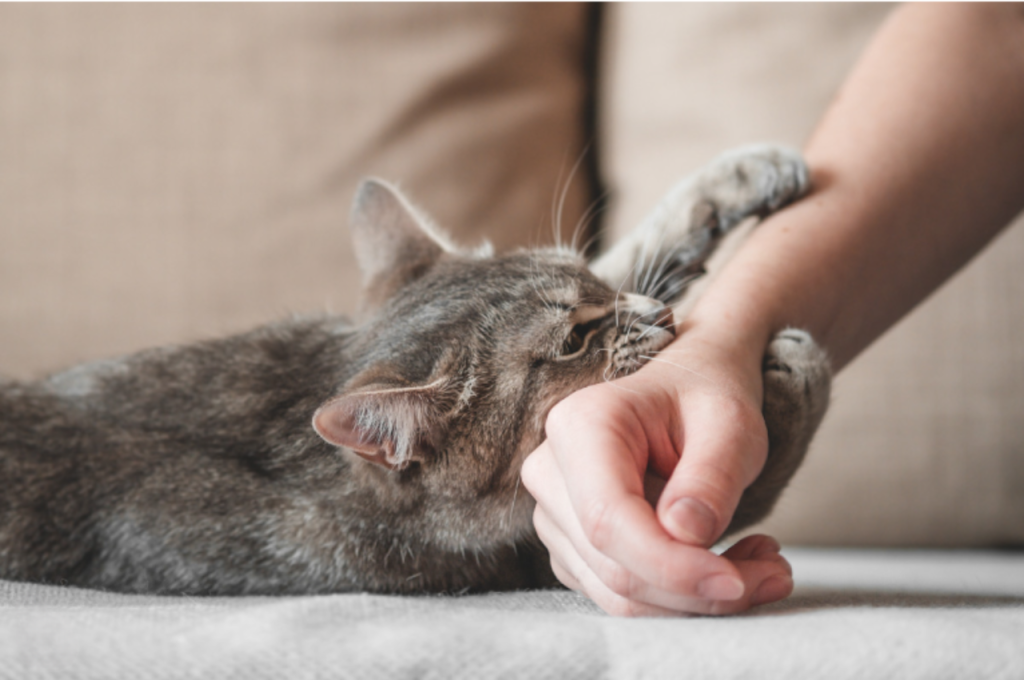Cats bite their owners due to various reasons such as playfulness, overstimulation, aggression, or illness. Understanding the cause of the behavior is crucial for resolving the issue and preventing future incidents.
Cats may also bite as a form of communication or to show affection. Cats are known for their playful and often unpredictable behavior, which can include biting. While some bites may be harmless playful nips, others can cause injury or be a sign of a more significant problem.
As a pet owner, it’s essential to understand why your cat may be biting you and how to prevent it. This article will discuss the various reasons cats bite, including playfulness, overstimulation, aggression, and illness, and provide tips on how to curb this behavior. We’ll also touch on how cats communicate through biting and encourage positive interactions between you and your feline friend.
Reasons for Cat Biting
Cat biting can be due to many reasons, such as fear, play aggression, or redirected aggression. It could also be a sign of an underlying health problem or discomfort. Understanding the reason for your cat’s biting behavior can help you address and correct the issue.

Reasons for cat biting include playfulness, fear or stress, health problems, overstimulation, and territorial behavior. Understanding the underlying reasons for your cat’s behavior is essential for maintaining a healthy and safe relationship with your feline companion.
Playfulness: Cats are natural predators and love to play. However, their hunting instincts can sometimes manifest as biting or scratching. If your cat is playfully biting you, it is usually not aggressive behavior. To discourage biting during playtime, provide alternative toys that your cat can chew on, such as stuffed animals or balls, and use positive reinforcement to reward good behavior.
Fear or stress: Cats may bite when they feel afraid or stressed. This could happen if they are placed in a new environment or if they are confronted with unfamiliar people or animals. If your cat is displaying fearful behavior, it is important to provide a safe and comfortable space for them to retreat to. Avoid provoking your cat and give them time to adjust to new situations gradually.
Health problems: Sometimes biting can be a sign of an underlying health issue. Dental problems or other types of pain can cause a cat to lash out. If your cat suddenly begins to bite or show other aggressive behavior, it may be worth scheduling a vet appointment to rule out any medical issues.
Overstimulation: Overstimulation is a common cause of biting. Cats have a threshold for affection and play, and when they have had enough, they may resort to biting. Recognizing your cat’s limits and stopping play or petting when they become overstimulated can help prevent biting.
Territorial behavior: Some cats may become territorial, especially when they feel their territory is being threatened. This could happen if you bring another pet into the home or if you move to a new residence. To avoid territorial biting, give your cat plenty of space and time to adjust to new surroundings or introductions to new animals.
Understanding why your cat may be biting is the first step toward addressing the behavior. By providing a comfortable and safe environment for your furry friend, you can help reduce their stress and aggressive behavior. Remember, treating your cat with patience, kindness, and respect is key to building a happy and healthy relationship.
Understanding Cat Body Language
Understanding cat body language can go a long way in preventing cat bites. As a pet owner, it’s essential to learn how to communicate with your feline friend effectively. Cats use a range of body signs to communicate how they feel, including their eyes, body posture, and vocalizations. In this blog post, we’ll explore one of the most common questions asked by cat owners: Why Does My Cat Bite Me?
Tail Position
A cat’s tail position can signal its mood and intentions. If a cat’s tail is straight up in the air, it indicates the cat is happy and relaxed. However, if the tail is twitching or lashing back and forth, it may signal agitation or anger. If a cat’s tail is tucked between its legs, they are frightened or stressed.
Ear Position
Like the tail, a cat’s ears also provide information about its mood. If a cat’s ears are forward and perked up, it typically means the cat is alert and happy. However, if the ears are flat and pointed backward, it may indicate aggression or fear.
Whisker Direction
Whiskers are sensitive organs that help cats navigate their surroundings. The direction of a cat’s whiskers can provide information about their mood. If the whiskers are forward, the cat is attentive and alert. However, if the whiskers are pulled back, it may signal a cat is feeling worried or threatened.
Pupil Dilation
A cat’s pupils can change size depending on their mood. When a cat’s pupils are dilated, it may signal excitement or fear. However, if the pupils are constricted, it may be a sign that the cat is feeling aggressive or upset.
Understanding cat body language is key to preventing cat bites. By paying attention to their tail position, ear position, whisker direction, and pupil dilation, you can communicate better with your cat and ensure mutual respect.
Techniques to Prevent Cat Biting
Cat biting can be caused by a variety of reasons such as play aggression, fear, or overstimulation. Techniques to prevent cat biting include redirecting your cat’s attention, setting clear boundaries, providing ample playtime, and seeking professional help if necessary.

If you’re the owner of a feline friend, you’ve probably experienced a cat bite at least once. While it’s natural for cats to bite as part of their instinctive behavior, it can be painful and problematic. Luckily, there are techniques you can use to prevent your cat from biting you.
Positive Reinforcement Training
One way to prevent biting is through positive reinforcement training. Positive reinforcement is the practice of rewarding good behavior, such as refraining from biting, with treats and praise. Whenever your cat displays good behavior, reward them with a treat or by petting them. This method helps to instill good habits in your cat and will discourage biting.
Providing Appropriate Toys
Another way to prevent biting is by providing appropriate toys for your cat to play with. Cats often bite out of boredom, so toys like scratching posts, balls, and catnip toys can keep them entertained and less likely to bite. It’s important to ensure that the toys are safe for cats to play with and are not too small to be swallowed.
Avoiding Overstimulation
Overstimulation is another common cause of cat biting. Cats can become overstimulated when they are petted for too long or in sensitive areas, such as their stomach or tail. To avoid overstimulation, make sure to pet your cat in areas they enjoy, such as on the head and chin. Additionally, pay attention to your cat’s body language and stop petting them if they become agitated or start to twitch their tail.
Allowing for Alone Time
Cats also need alone time to rest and recharge. If your cat is overstimulated or feeling stressed, provide them with a quiet place to relax and be alone. This can be a separate room or a cozy cat bed where they can retreat when they need to be alone. By allowing for alone time, you can prevent your cat from feeling overwhelmed and less likely to bite.
Respecting Cat’s Body Language
Lastly, it’s essential to respect your cat’s body language, as it’s their way of communicating with you. If your cat’s ears are flattened or their tail is twitching, they may be feeling agitated and may be prone to biting. Avoid interacting with your cat in these situations and give them the space they need to calm down. Paying attention to your cat’s body language can help prevent biting and maintain a positive relationship with your furry friend.
How to React When A Cat Bites
It can be alarming when a cat bites, but understanding why it’s happening can help prevent future incidents. Cats may bite due to overstimulation, fear, or territorial aggression. React calmly and remove yourself from the situation to give both you and your cat time to calm down.
Cats are often known for their playful and affectionate nature. However, there may be a time when your cat bites you, leaving you feeling confused and hurt. While cat bites may sometimes seem harmless, they can lead to serious infections and require prompt first aid and medical attention.
Remaining Calm
The first step to take when a cat bites you is to remain calm. It’s important not to scream, hit, or startle the cat further as this might aggravate the situation. Most cats bite out of fear, nervousness, pain, or irritation, so staying calm can help diffuse the situation.
Withdrawing Attention
Once you have calmed the cat down, the next thing to do is to withdraw your attention. Do not shout or scold the cat as this might cause further scratching or biting. Instead, calmly move away from the cat and avoid interacting with it until its mood changes.
Providing First Aid
If you have been bitten, wash the wound thoroughly with soap and running water. Apply an antiseptic cream or lotion to the wound and cover it with a clean dressing. Monitor the wound for any signs of swelling, redness, or pus formation as these may indicate an infection. If the wound shows any signs of infection, seek medical attention immediately.
Seeking Medical Attention for Serious Bites
Serious cat bites, especially to the hands, can cause deep puncture wounds that may get infected with bacteria. Severe bites that show signs of infection such as swelling, severe pain, fever, and redness require immediate medical attention. Seek medical treatment from a qualified healthcare provider who can advise on the appropriate antibiotics and tetanus shots needed.

Conclusion
We can say that biting is a normal behavior for cats but sometimes it may be due to underlying health problems. Understanding the causes, such as fear, aggression, or anxiety, can help prevent and manage biting behavior. It is important to give your cat plenty of love, attention, and a suitable environment to reduce their stress levels.
Remember to always handle your cat with care and respect their boundaries to ensure a happy and healthy relationship.
